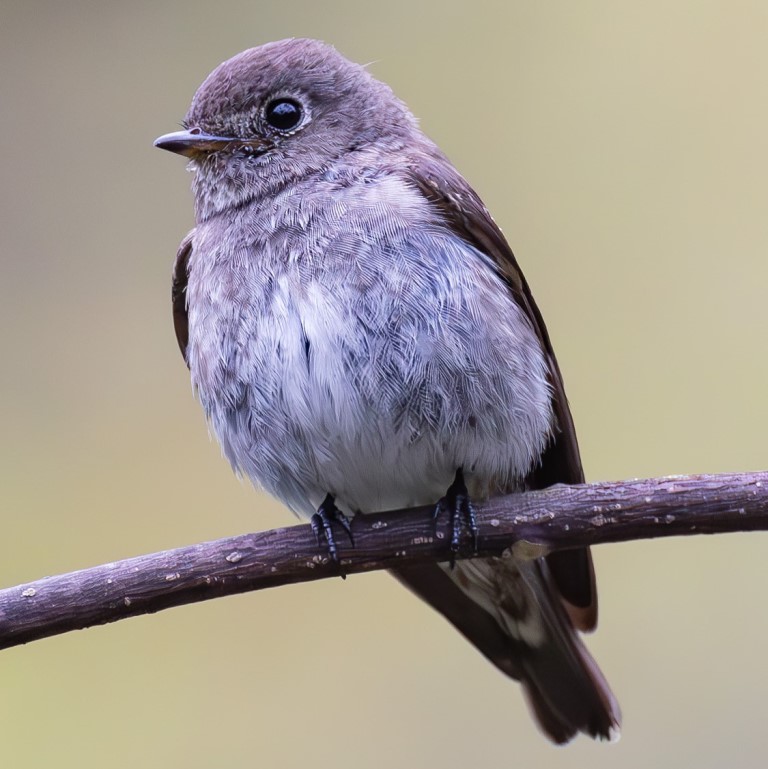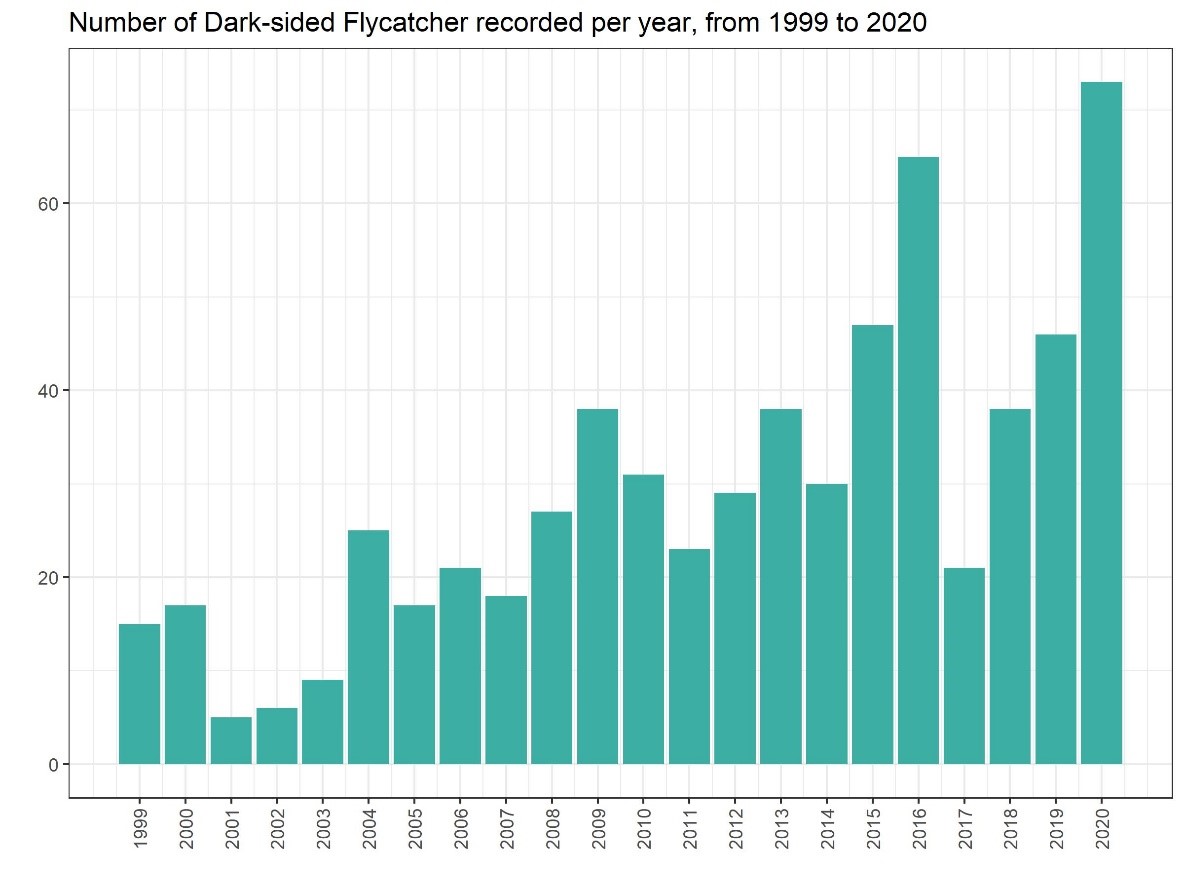Dark-sided Flycatcher Muscicapa sibirica 烏鶲
Category I. Passage migrant to lightly wooded areas or forest edge, fairly common in autumn but rare in spring.
IDENTIFICATION

Oct. 2008, Michelle and Peter Wong. First-winter.
13-14 cm. Short, fine bill, obvious white orbital ring that is broadest behind the eye. Dark centres to the longest undertail coverts, if present, are diagnostic.
First-year birds occur most frequently and are identified by broad pale fringes to the greater coverts and tertials. In addition, this is one of only a few passerine species in which obvious retained juvenile feathers are regularly seen on migrants in HK. These feathers, when present, have white spots at the tip and can be seen on the upperparts. The breast is mottled dark, often giving a scaly appearance.

Nov. 2016, Michelle and Peter Wong. Adult.
Adult has sooty-grey head and upperparts, a poorly defined white half-collar and submoustachial stripe. The throat and underparts are off-white with dark mottling or diffuse dark-grey streaks on the breast and flanks. The lower belly is white. The bill is black but sometimes shows yellow at the base of the lower mandible.
Dark-sided rarely has such prominent pale lores as Asian Brown and the wings are longer (primary projection equal to or up to 20% longer than exposed tertials) (Leader 2010). The dark tips to the undertail coverts that are diagnostic of this species among the three brown flycatchers occurring in HK are visible, though barely, on this bird.

Mar. 2024, Michelle and Peter Wong.
The western races of Dark-sided Flycatcher are darker and less streaked below with the pale area on the belly much reduced and, due to the dark undertail coverts, typically an isolated pale patch. The pale throat patch is narrower and smaller.
VOCALISATIONS
Calls vary somewhat but typical is a high-pitched metallic ‘chit’ that can be uttered singly or as a rapid short series of notes.
Also, a harsher, flatter, lower-pitched sound.
DISTRIBUTION & HABITAT PREFERENCE
Widespread, occurring where suitable cover for migrants exists. Noted most regularly in wooded areas in the central New Territories, as well as in more open country where trees are available. Also frequent on offshore islands, particularly Po Toi.
OCCURRENCE
In autumn it has occurred from 26 August to 29 December. It is very uncommon during the last week of August; the first birds usually occur in the first week of September. Peak passage takes place from mid-September to the first week of October with 46% of records in the period 1999 – 2020 occurring between 15 September and 8 October. It is now regularly recorded, albeit in smaller numbers, to the third week of November, which contrasts with the situation to the end of the 1990s when it was rarely recorded after the middle of October (Figure 1).
Very small numbers have been recorded in December in eight years from 1999 to 2020. It is rarely recorded in spring, with all records being single birds from 31 March to 8 May, though three occurred at separate sites in 2012.
The highest count is of five at Tai Po Kau on 19 September 2009. Overall numbers have shown a marked increase since 2009 that, although seemingly real, must also be due in part to an increase in observer activity. Up to the year 2000 the estimated annual number of individuals was generally in single digits or low double digits; in contrast, there were counts of 38 in 2009 and 2013, rising to 65 in 2015 and 73 in 2020.
All HK reports are of the nominate subspecies, except for three records of one of the Himalayan taxa (probably rothschildi on range): singles at Pui O on 29 December 2013 (Allcock 2015) and Shek Kong in March 2024.
Dark-sided Flycatcher was first recorded in 1974 and was considered a vagrant by Chalmers (1986), with only three records. However, it was noted regularly after 1986 due to a better understanding of its identification.
BEHAVIOUR, FORAGING & DIET
Usually occurs singly. When catching flying insects tends to select a favoured exposed perch to which it frequently returns; this may often involve a long acrobatic flight.
RANGE & SYSTEMATICS
Dark-sided Flycatcher breeds from the Himalayas to western China, and in northeast Asia south to Japan; it winters in Indochina, Burma, Thailand, Malaysia and the Greater Sundas. Nominate M. s. sibirica breeds in central and southeast Siberia, north Mongolia, northeast China, North Korea and northern Japan, and winters in Indochina, Thailand, Malaysia and Borneo (Clement 2020). In China, it breeds in Inner Mongolia, Liaoning and Jilin, and is found on passage throughout the southeast coastal provinces (Liu and Chen 2021).
There are three darker western races. M. s. rothschildi breeds in central China (southeast Qinghai and southeast Gansu south to eastern Tibet, Sichuan and west Yunnan), Myanmar and, possibly, north Vietnam; it winters in Indochina, the Malay Peninsula and Sumatra. M. s. cacabata breeds in the Himalayas east to southern Tibet, Bhutan and Northeast India, and winters in south Myanmar and south Thailand. M. s. gulmergi breeds in northeast Afghanistan east to northern India; its wintering area is unknown (Clement 2020).
CONSERVATION STATUS
IUCN: Least Concern. Population trend stable.
Figure 1.

Figure 2.

Allcock, J. A. (2015). Dark-sided Flycatcher Muscicapa sibirica at Pui O, Lantau. The first HK record for the subspecies rothschildi/ cacabata/ gulmergi. Hong Kong Bird Report 2013: 296-300.
Chalmers, M. L. (1986). Annotated Checklist of the Birds of Hong Kong. Hong Kong Bird Watching Society, Hong Kong.
Clement, P. (2020). Dark-sided Flycatcher (Muscicapa sibirica), version 1.0. In Birds of the World (J. del Hoyo, A. Elliott, J. Sargatal, D. A. Christie, and E. de Juana, Editors). Cornell Lab of Ornithology, Ithaca, NY, USA. https://doi.org/10.2173/bow.dasfly.01
Leader, P. J. (2010). Brown, Siberian and Grey-streaked Flycatchers: identification and ageing. British Birds 103: 658-671.
Liu, Y. and S. H. Chen (eds) (2021). The CNG Field Guide to the Birds of China (in Chinese). Hunan Science and Technology Publication House.

